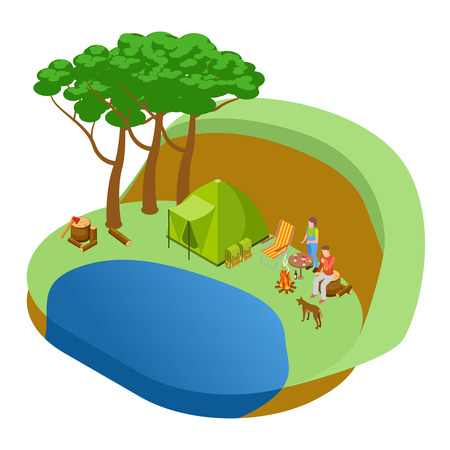1. Choose the Right Grass Type
When it comes to keeping your lawn green and healthy during hot American summers, one of the most important steps is choosing the right type of grass. Not all grasses are built to handle extreme heat, so picking a variety that thrives in high temperatures is key—especially in regions where summer heat can be intense and prolonged.
Why Grass Type Matters
Certain grass types are naturally more drought-tolerant and heat-resistant than others. If you plant a cool-season grass in a hot climate, it may struggle, turn brown, or even die off during peak summer months. On the other hand, warm-season grasses are built to thrive in the heat, making them ideal for southern and some central parts of the United States.
Best Warm-Season Grasses for Hot Climates
If you live in a region with hot summers—like Texas, Florida, Arizona, or Southern California—consider using one of these warm-season grasses:
| Grass Type | Main Features | Best Regions |
|---|---|---|
| Bermudagrass | Very heat-tolerant, grows fast, durable for foot traffic | Southeast, Southwest, Southern Plains |
| Zoysiagrass | Drought-resistant, thick texture, handles shade better than Bermuda | Southeast, Mid-South |
| St. Augustinegrass | Tolerates heat and humidity well, coarse texture, good for coastal areas | Southeast, Gulf Coast |
| Bahiagrass | Tough under dry conditions, low maintenance | Southeast (especially Florida) |
| Centipedegrass | Simpler care needs, slow-growing, prefers acidic soil | Southeast U.S. |
Caring for Warm-Season Grasses
No matter which variety you choose, make sure to follow proper watering and mowing practices specific to your grass type. Each species has its own ideal mowing height and watering frequency. Getting familiar with these details will help your lawn stay vibrant even when temperatures soar.
A Quick Tip:
If youre unsure which grass type is best for your area, reach out to your local extension office or garden center. They can recommend varieties that perform well in your local climate and soil conditions.
The Bottom Line on Grass Types
Selecting the right grass isnt just about looks—its about long-term success. By choosing a heat-tolerant variety suited to your regions climate, youll lay the foundation for a lawn that stays green and healthy all summer long.
2. Water Smartly and Efficiently
Keeping your lawn green during the hot American summer starts with smart watering habits. Its not just about how much water you use—its also about when and how you apply it. Using the right techniques can help your lawn stay hydrated, reduce water waste, and encourage deep root growth for long-term health.
Best Time to Water
The early morning, ideally between 5 AM and 9 AM, is the best time to water your lawn. During this time, temperatures are cooler and winds are typically calmer, which helps reduce evaporation. Watering in the morning also gives grass blades time to dry out during the day, reducing the risk of fungal diseases.
How Much Water Does Your Lawn Need?
Most lawns need about 1 to 1.5 inches of water per week, either from rainfall or irrigation. You can measure this with a simple rain gauge or even a small empty tuna can placed on your lawn while sprinklers run.
| Type of Grass | Weekly Water Requirement |
|---|---|
| Bermudagrass | 1 – 1.25 inches |
| Kentucky Bluegrass | 1 – 1.5 inches |
| Zoysiagrass | 0.5 – 1 inch |
Irrigation Tips for Efficiency
- Water deeply but infrequently: Aim for two to three watering sessions per week instead of daily light watering. This encourages deeper root growth.
- Avoid watering during peak heat: Midday watering leads to high evaporation and wasted water.
- Use a sprinkler timer: Automatic timers help maintain consistency without overwatering.
- Avoid runoff: If water starts running off before its absorbed, break up watering into shorter cycles with rest periods in between.
Signs Your Lawn Is Thirsty
If youre unsure whether your lawn needs water, look for these signs:
- Bluish-gray color on the grass blades
- Patches that don’t spring back when stepped on
- Curling or wilting leaves
Lawn Care Tip:
If local regulations limit watering days due to drought conditions, prioritize deep watering on allowed days and mow your grass at a higher setting to help retain soil moisture.

3. Mow at the Proper Height
One of the easiest ways to help your lawn stay green and healthy during hot American summers is by adjusting your mowing height. Cutting your grass too short can put it under a lot of stress, especially when temperatures soar. Taller grass shades the soil, keeps roots cooler, and helps conserve moisture—all of which are key to surviving the summer heat.
Why Mowing Height Matters
When you mow your lawn too low in the summer, it exposes more soil to direct sunlight, causing it to dry out faster. This not only leads to brown patches but also weakens your grass, making it more vulnerable to weeds and disease. On the other hand, letting your grass grow a bit taller helps it develop deeper roots and retain water better.
Recommended Mowing Heights by Grass Type
Here’s a quick guide to recommended mowing heights for popular U.S. grass types during summer:
| Grass Type | Recommended Summer Mowing Height (inches) |
|---|---|
| Kentucky Bluegrass | 2.5 – 3.5 |
| Bermudagrass | 1.5 – 2.5 |
| Zoysiagrass | 1.5 – 2.5 |
| Tall Fescue | 3.0 – 4.0 |
| St. Augustinegrass | 2.5 – 4.0 |
Mowing Tips for Hot Weather
- Avoid cutting more than one-third of the grass blade at once. This reduces stress on the plant and keeps it healthier.
- Mow during cooler parts of the day. Early morning or late evening is best to avoid additional heat stress.
- Keep mower blades sharp. Dull blades tear the grass instead of cutting it cleanly, which can lead to browning and disease.
- Leave grass clippings on the lawn. They act as natural mulch, helping retain moisture and returning nutrients to the soil.
Mowing at the right height is a simple change that can make a big difference in how your lawn handles summer heat. With just a little attention to your mowing routine, you can protect your lawn from stress and keep it looking lush all season long.
4. Feed Your Lawn with the Right Nutrients
During the hot American summer months, your lawn needs extra care to stay green and healthy. One of the most important steps is feeding it with the right nutrients. The key is to choose a fertilizer that supports growth without stressing your grass in the heat.
Understand Summer-Friendly Fertilizers
Not all fertilizers are created equal, especially when it comes to summer lawn care. You want a product that contains slow-release nitrogen. This type of fertilizer provides nutrients gradually, reducing the risk of burning your lawn and helping it grow steadily through the heat.
Common Types of Fertilizers for Summer Use
| Fertilizer Type | Main Nutrients | Best For |
|---|---|---|
| Slow-Release Granular | Nitrogen (N), Potassium (K) | Consistent feeding over time |
| Liquid Fertilizer | Nitrogen (N), Phosphorus (P), Potassium (K) | Quick boost during stressful periods |
| Organic Fertilizer | Natural sources of N-P-K | Eco-friendly option for steady nourishment |
How to Apply Without Burning Your Grass
Applying fertilizer correctly during the summer is just as important as choosing the right one. Here are some tips to avoid damaging your lawn:
- Water First: Always water your lawn a day before applying fertilizer to prevent root burn.
- Avoid Midday Heat: Apply fertilizer early in the morning or late in the afternoon when temperatures are cooler.
- Follow Label Instructions: Stick to recommended amounts—more isn’t always better.
- Irrigate After Application: Lightly water your lawn after applying fertilizer to help nutrients soak into the soil.
Pro Tip:
If you’re unsure about what your lawn needs, consider doing a soil test. It’s an easy way to find out which nutrients are lacking and adjust your fertilization plan accordingly.
A well-fed lawn can handle summer stress much better, so giving it the right nutrients at the right time will help keep it lush and green even under the hot American sun.
5. Control Weeds and Pests Naturally
Hot American summers can create the perfect environment for weeds and pests to thrive, which can stress your lawn and make it harder to stay green and healthy. Instead of turning to harsh chemicals, there are natural and eco-friendly ways to manage these common problems.
Natural Weed Control Methods
Weeds compete with your grass for water and nutrients, especially during hot and dry conditions. Here are a few safe and effective ways to reduce weeds:
| Method | Description |
|---|---|
| Hand Pulling | Remove weeds by hand or with a weeding tool, especially after watering when the soil is softer. |
| Corn Gluten Meal | A natural pre-emergent that prevents weed seeds from sprouting without harming your grass. |
| Mulching | Use organic mulch in garden beds to block weed growth and retain moisture. |
| Mow High | Keep grass at a taller height (around 3 inches) to shade out weed seeds and reduce germination. |
Eco-Friendly Pest Management
Pests like grubs, chinch bugs, and aphids can weaken your lawn during summer heat. Try these natural methods to keep them under control:
| Pest Control Method | How It Works |
|---|---|
| Nematodes | Tiny beneficial worms that target and kill lawn grubs without harming other insects or pets. |
| Diatomaceous Earth | A fine powder made from fossilized algae; sprinkle it on affected areas to deter soft-bodied pests. |
| Neem Oil Spray | A plant-based oil that disrupts pest feeding and reproduction—safe for pets and pollinators. |
| Encourage Birds & Beneficial Insects | Create a habitat with bird feeders or flowering plants to attract natural predators of lawn pests. |
Tips for Success
- Regularly inspect your lawn so you can catch weed or pest issues early.
- Avoid overwatering, as damp conditions can encourage both weeds and harmful insects.
- Keep your lawn healthy with proper mowing, watering, and fertilization to naturally resist invaders.
By choosing these environmentally friendly solutions, you’ll not only protect your lawn but also support local ecosystems during those hot American summer months.


